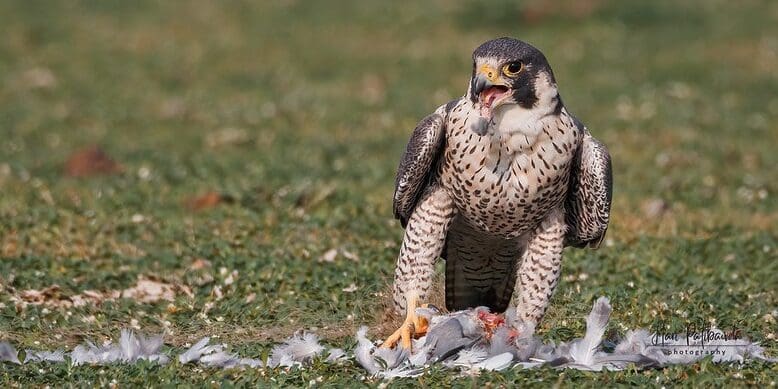The lonely tuatara
Will Morgan is a Postdoctoral Research Associate at Conservation Evidence and is currently working on the Reptile Conservation synopsis.

Two bird feeders hang on an apple tree in the front garden. One filled with peanuts, the other with sunflower hearts. I read online that gold finches have a particular fondness for sunflower hearts and so, armed with this knowledge—and a very poor conception of the weight of seed—I bought a 15 kg bag. While the bag is almost comically large, the seeds have done the trick and goldfinches have started visiting the garden. They can now be seen regularly engaging in aerial battles with the sparrows and great tits as they jostle for a position at the feeder, while black birds, a couple of feral pigeons and occasionally a collared dove hoover up after the messy birds above. Now of course any conclusions I might draw about the preference goldfinches show for sunflower hearts from this before-and-after study with a sample size of one are not particularly robust, but that is a story for another day.
The story that interests me today is one of a shared space, where many species come together to feed, squabble, and simply exist. I am often struck by our own comparative loneliness as a species, and wonder what the consequences of this may be for our sense of belonging in the natural world around us.
While this story has started in a garden in Cambridge, for the next part we must travel to the other side of the world to New Zealand; home of the tuatara, one of the loneliest species on the planet.

Sphenodon punctatus—commonly known as the tuatara, meaning ‘peaks on the back’ in the Māori language—is often described as a lizard-like reptile, but is in fact a member of the ancient order Rhynchocephalia. This order emerged during the Triassic period some 250 million years ago, around 10 million years before the first dinosaurs. Throughout the Triassic and Jurassic periods rhynchocephalians developed into a globally distributed group of reptiles and the order included species with a wide variety of ecological adaptations to life on the land, as well as in the water. However, the cretaceous period saw the rhynchocephalians enter a gradual but inexorable decline. Whether caused by greater competition with the increasing number of other squamate reptiles (lizards and snake), small mammals and dinosaurs, or due to some other, as of yet unknown reason, the number of rhynchocephalian species continued to decrease, until around 60 million years ago, the tuatara was the last one left.
To put that into context, around 55 million years ago, when the first primate species were beginning to appear, the tuatara was already alone, and modern humans are more closely related to kangaroos than the tuatara is to a lizard.
Perhaps the most astonishing thing is that the tuatara is still here today. Isolated both taxonomically and geographically, it has persisted for millions of years on the islands that constitute modern day New Zealand; a relic of a bygone age, and snapshot of the world that was.
While the degree to which tuatara have changed over their 200-million-year history is still up for debate, they do retain some surprising features that provide a hint of their connection with a time when reptiles ruled the earth. For example, a tuatara’s teeth are fused directly to their jawbone, and they also lack any openings for their ears. Like a number of other lizard species, tuatara also possess a third eye, or parietal eye, on the top of their head, complete with rudimentary lens, retina and nerve endings. While this ‘eye’ is covered by scales from a young age and not used for vision, it may play a role in regulating basking behaviour and other circadian rhythms.
As with so many geographically isolated species, it was with the arrival of humans and their unofficial menagerie of exotic mammals—particularly rodents—that so nearly spelled disaster for the tuatara. Once found across the whole of New Zealand’s mainland, tuataras are now mostly confined to a few isolated islands formed by post-glacial rising sea-levels 8,000–12,000 years ago. But fortunately, that is not where their story ends. Over the last few decades, a number of conservation projects have been mobilised to help safeguard the future of this truly unique reptile. Large scale removal of invasive, non-native mammals; translocations of tuatara to islands where rats have been successfully eradicated; and captive breeding, rearing and release programmes have all played an important role in conserving the tuatara. Some attempts have even been made to reintroduce the tuatara back to parts of its historic range on New Zealand’s North Island, though ongoing control of non-native mammals is likely vital for the long-term success of these efforts.
Though not so lonely as the tuatara, we humans Homo sapiens have become increasingly isolated from our genetic relatives over the last 100,000 years and are now the last surviving member of our genus Homo. Given that every member of our wider family—the Hominidae, which includes the orangutans, gorillas, bonobos and chimpanzees—is currently rated as ‘Endangered’ or ‘Critically endangered’ on the IUCN Red List, then we may consider that the self-styled ‘Wise man’ is fast becoming the ‘Lonely man’.
It is a poignant thought, the consequences of which may be difficult to comprehend. But maybe the solution is close at hand. We have changed our habits out of necessity over the last year and many of us have found some comfort in going back out into nature and reacquainting ourselves with the sights, sounds and rhythms of the living world. Maybe by rediscovering our connection to this non-human life we can overcome our isolation, and maybe gazing out of the window and watching the birds is a good way to start.
Some readings and other materials that informed and inspired this post:
- Hay J.M., Sarre S.D., Lambert D.M., Allendorf F.W. & Daugherty C.H. (2010) Genetic diversity and taxonomy: a reassessment of species designation in tuatara (Sphenodon: Reptilia). Conservation Genetics, 11, 1063–1081.
- Apesteguía S. & Jones M.E.H. (2012) A late cretaceous “tuatara” (Lepidosauria: Sphenodontinae) from South America. Cretaceous Research, 34, 154–160.
- Jones, M.E. & Cree A. (2012) Tuatara. Current Biology, 22, R986-R987.
- Meloro, C. & Jones, M.E.H. (2012) Tooth and cranial disparity in the fossil relatives of Sphenodon (Rhynchocephalia) dispute the persistent ‘living fossil’ label. Journal of Evolutionary Biology, 25, 2194–2209.
- Herrera‐Flores, J.A., Stubbs T.L. & Benton M.J. (2017) Macroevolutionary patterns in Rhynchocephalia: is the tuatara (Sphenodon punctatus) a living fossil? Palaeontology, 60, 319–328.
- ‘What On Earth Is A Tuatara? | Modern Dinosaurs’ (2019). https://www.youtube.com/watch?v=44JUXPzEI2U
- ‘6 Lonely Branches on the Tree of Life’ (2020). https://nerdfighteria.info/v/XG3uDAaEaJY/
Some studies of tuatara conservation projects that will feature in the upcoming Conservation Evidence synopsis on reptile conservation
- Nelson N.J., Keall S.N., Brown D. & Daugherty C.H. (2002) Establishing a new wild population of tuatara (Sphenodon guntheri). Conservation Biology, 16, 887–894.
- Towns D. (2005) Eradication of introduced mammals and reintroduction of the tuatara Sphenodon punctatus to Motuhora (Whale Island), New Zealand. Conservation Evidence, 2, 92–93.
- Keall S.N., Nelson N.J. & Daugherty C.H. (2010) Securing the future of threatened tuatara populations with artificial incubation. Herpetol Conserv Biol, 5, 555–562.
- Price S.J., Grayson K.L., Gartrell B.D. & Nelson N.J. (2018) Survival and growth of tuatara Sphenodon punctatus following translocation from the Cook Strait to warmer locations in their historic range. Oryx, 54, 222–233.




[…] synopses seems to grow longer by the month, and with the reptile synopsis due out later this year [read about it here], we are close to having produced synopses for all vertebrate groups (just freshwater fish left to […]
[…] whose modern day descendants are lizards, snakes, amphisbaenians and tuatara (arguably the loneliest reptile still living today). This was followed by the appearance of Archosauromorphs, which include crocodilians, as well as […]